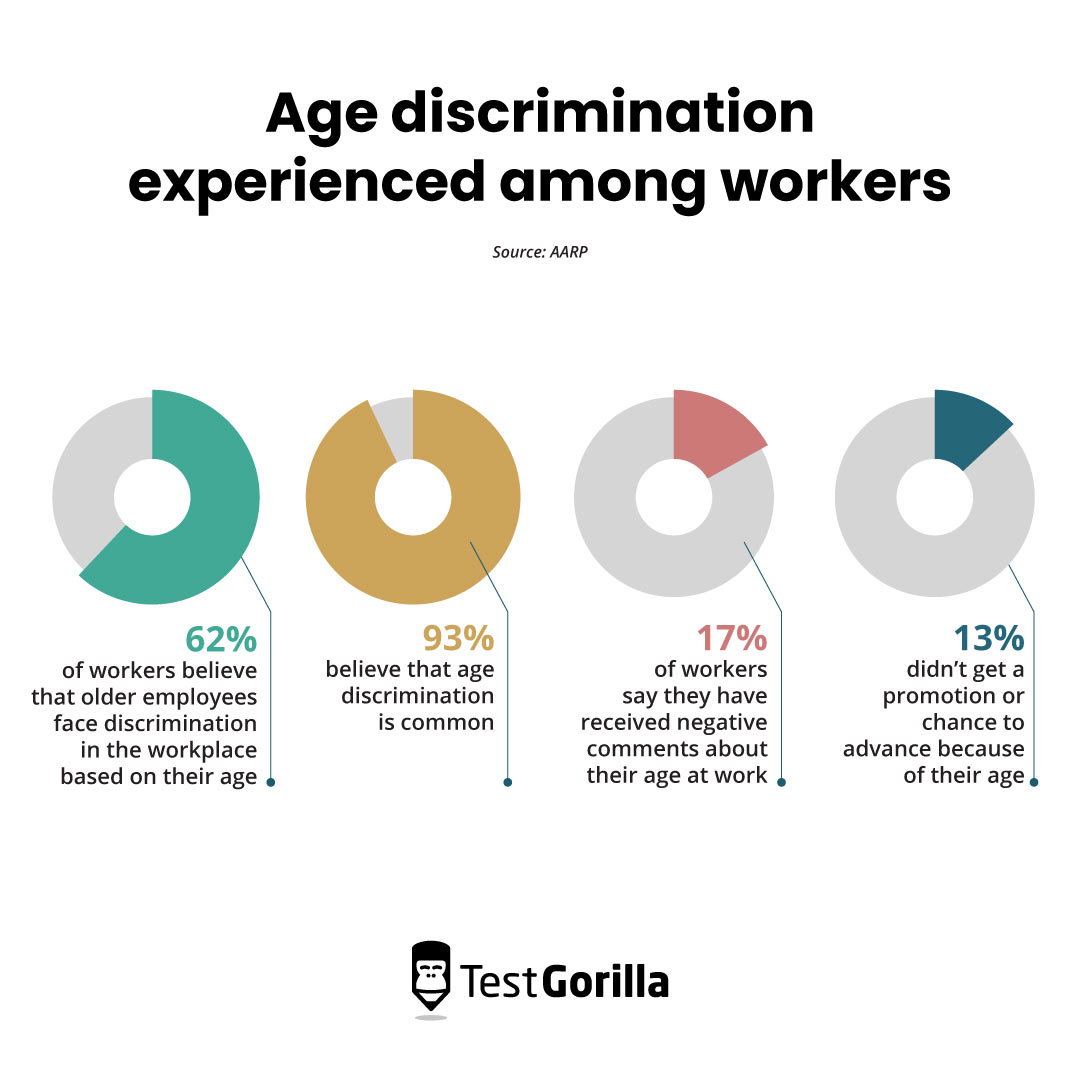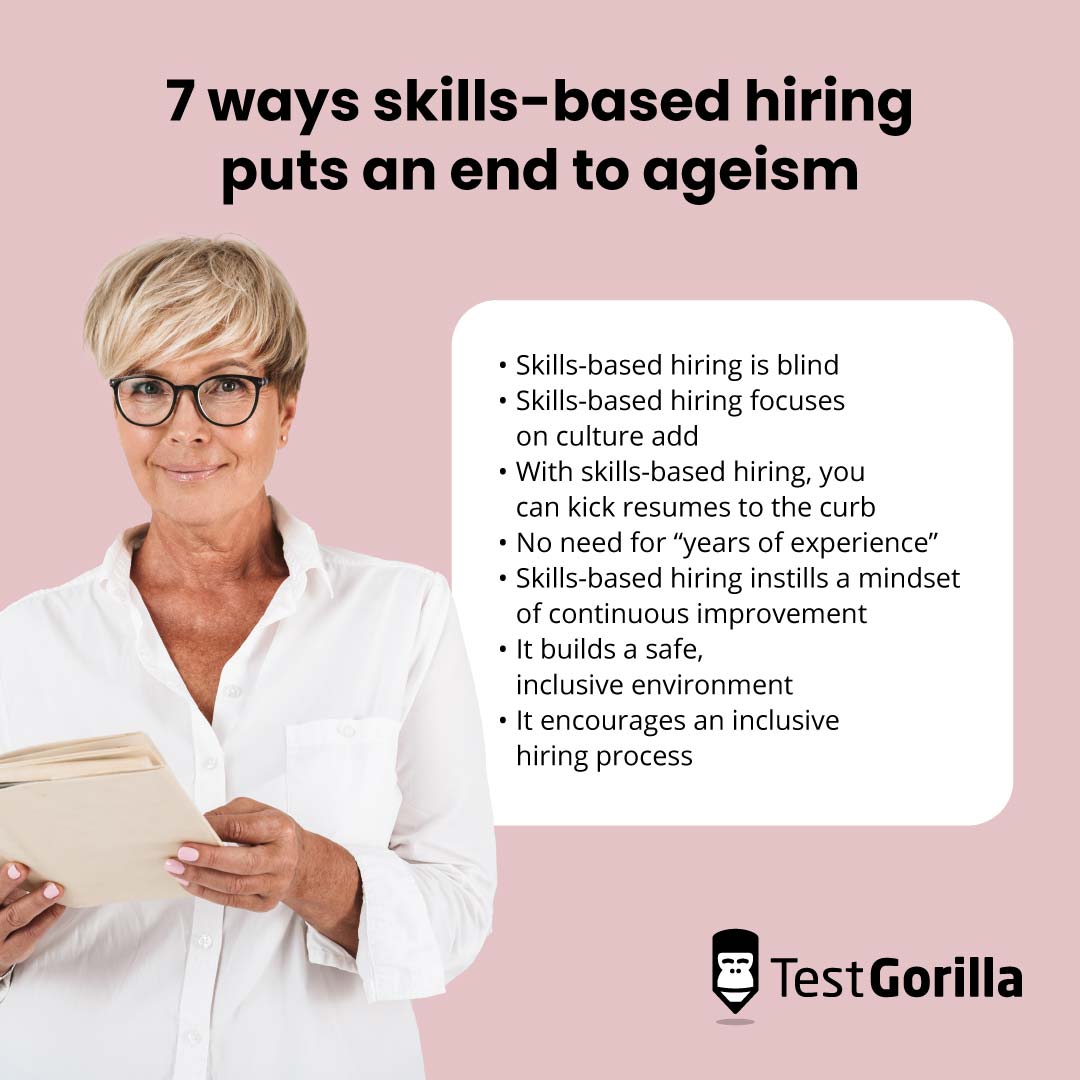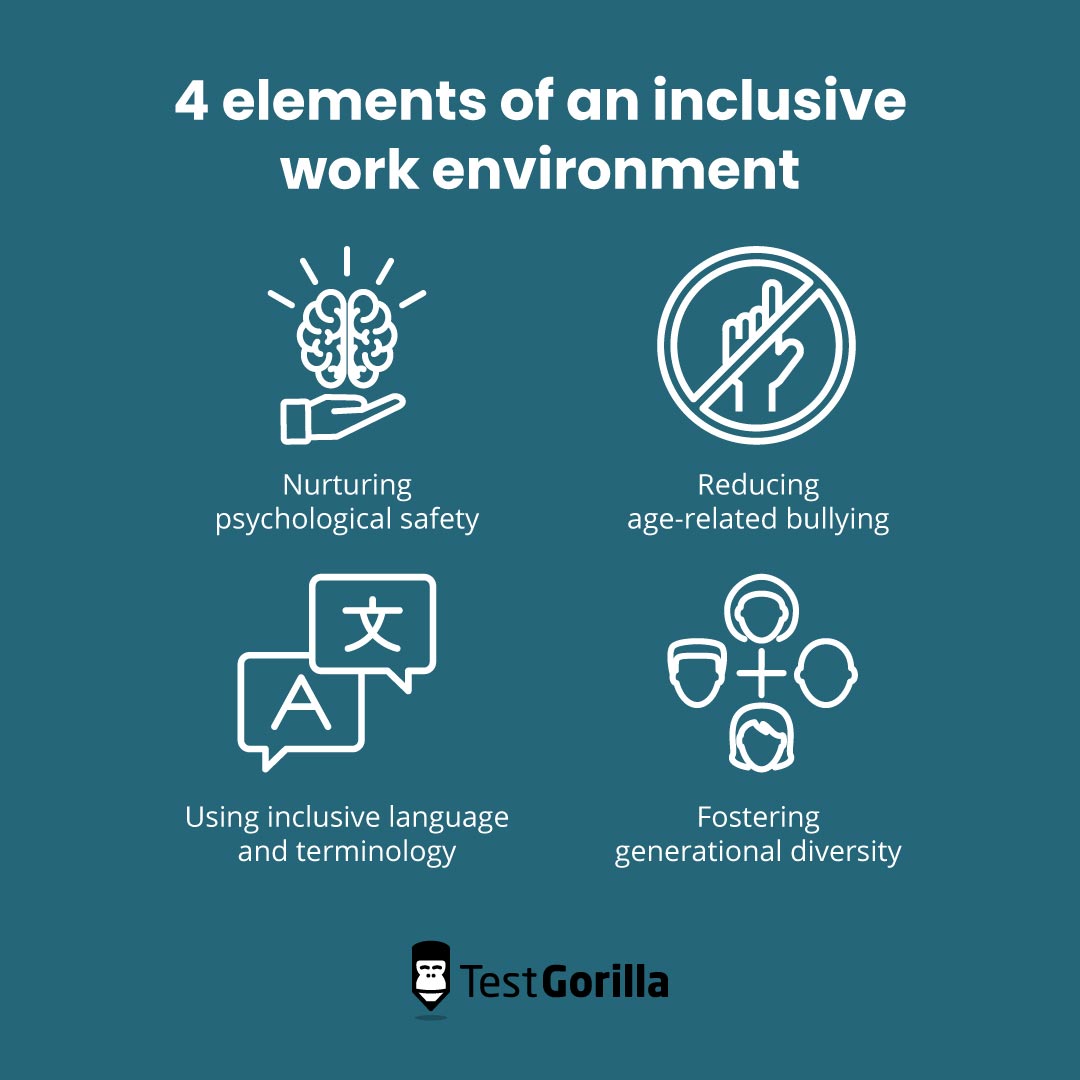How skills-based hiring ends ageism and our obsession with age
“You’re overqualified.”
“We’re looking for a youthful digital native.”
The hiring world is obsessed with age.
After decades of linking stereotypes to certain ages, it’s become second nature to assume that younger workers are inexperienced or older workers can’t learn complicated programming.
It’s about time we stopped thinking of people as either “too young” or “too old” for a position and started looking at individual skills instead.
Is the candidate able to get the job done? Yes? Then hire them.
The mission of skills-based hiring practices is precisely that. Assess skills and competencies, reduce bias, and hire the ideal candidate.
In this article, we take an in-depth look at how skills-based practices help us end the working world’s obsession with age and take the first important steps to end ageism in the workplace.
The issue of ageism in hiring
Ageism in hiring is when you treat a candidate differently, usually in a less favorable way, owing to their age.
We wish we could say this is a rare phenomenon, but it isn’t just the odd hiring manager perpetuating age discrimination.
The hiring world encourages ageism.
This discrimination appears in many areas, from hearing “you’re overqualified” to an ideal candidate profile listing a preferred age range of 25 to 35.
Some companies even advertise their bias as a hook to attract potential applicants, saying things like, “Join a young, vibrant team of digital nomads,” not realizing how off-putting this is for older candidates.
Age discrimination is also much more common than you’d think.
One study found that 62% of workers believe that older employees face discrimination in the workplace based on their age, and among them, 93% believe that age discrimination is common.
The study also found that 17% of workers say they have received negative comments about their age at work, and 13% didn’t get a promotion or chance to advance because of their age.
Age discrimination is also worsening unemployment for older workers.
A report by Generation, a career training organization, found that 63% of unemployed people older than 45 have been out of work for longer than a year, versus 52% of job seekers 35 to 44 and just 36% of job seekers 18 to 34.
At this point, you could wonder – isn’t age discrimination illegal?
Age discrimination is indeed illegal in many parts of the world, but that doesn’t stop it from happening.
Some employers are simply getting away with it because ageism stems from unconscious bias, which is rampant but immeasurable.
For a deeper look into this topic, read our full blog on age discrimination.
How traditional hiring encourages ageism
Traditional hiring practices enable and promote ageism.
Here we’ll look at three of the main ways the standard hiring world encourages age discrimination.
It encourages candidates to misrepresent their ages
Traditional job applications may ask for age in a roundabout way, like asking for a person’s graduation date or asking them for a timeframe for their past work experiences.
This practice causes hiring and recruiting experts to encourage candidates to misrepresent their ages, or purposefully neglect to mention it.
It isn’t unusual to hear, “Just lie about your age” or “You’d pass for 35” from well-intentioned recruiters.
Many professionals also tell candidates to exclude work timelines from previous positions because it “signals your age to recruiters.”
Most of these hiring experts mean well, but this shouldn’t be normal, and it’s no way for a society to run.
This attitude is psychologically damaging to candidates and perpetuates ageism and a bias toward older workers.
It’s built around ageist stereotypes
Traditional hiring nurtures and perpetuates harmful (untrue) stereotypes.
Here are a few common stereotypes based on generation:
Gen Z’ers are “fast-paced” and “on three devices at once”
Millennials are “technology-obsessed” and “job-hoppers”
Baby Boomers are “slow to learn new software” and “stubborn in their ways”
Older workers, in particular, face dozens of ageist stereotypes, such as having poor health or poor memory.
It’s also important to note that hiring managers have many interwoven biases that they don’t notice surfacing.
That’s the problem with unconscious bias.
Even the most well-intentioned hiring managers can fall victim to it because it happens without their conscious knowledge.
It perpetuates the need for a perfect number of years of experience
It’s woven into the fabric of a traditional hiring process that you need a “sweet spot” of experience.
Younger generations struggle to get in the door because they have no work experience, but older workers fail as “overqualified” because they have more than eight years of experience.
And “overqualified” often translates to “too old to hire” and “expects higher pay than a young graduate.”
Suppose we step away from this obsession with years of experience. In that case, we help reduce ageism and build a fairer working world for thousands of people with alternative experiences.
The best insights on HR and recruitment, delivered to your inbox.
Biweekly updates. No spam. Unsubscribe any time.
Why it’s time to end our obsession with age
Our society has a lot of firmly held beliefs and biases around the topic of age. The working world is thinking about age in a wrong and harmful way, and it’s time to stop.
We encourage all organizations to end ageism, reduce bias, and adopt the core belief that age does not equal capability.
Improving your recruitment process does a lot more than affect your hiring initiatives. It also shapes how society looks at workers and, ultimately, people of all ages.
By making these values a priority, you aren’t just doing the right thing and securing top talent, you’re paving the way for future generations.
Everybody gets older, so improving this system benefits your generation and future generations.
Perpetuating a mindset stuck on “younger is better” only hurts our society’s future. Telling a candidate to “try passing for 35” is damaging and only promotes our culture’s biased view on age.
Margaret Morganroth Gullette, a resident scholar at the Brandeis University Women’s Studies Research Center, made a powerful statement on combating ageism.
“It’s a bit like telling other victims, ‘Start now to try being less Black . . . less disabled . . . less Jewish.’ Passing for younger is futile, and internally painful,” she said.
Margaret says that only leaders willing to name the perpetrators and describe the factors that worsen them can fight societal problems like ageism, racism, and ableism.
We believe leaders should take a firm stance on ageism and let the world know it’s unacceptable.
It starts with adopting skills-based hiring. Through this process, your organization can lead the way to shift mindsets about age and focus on what matters: talented people.
The top 7 ways skills-based hiring ends ageism
Wherever traditional hiring perpetuates ageism, skills-based hiring is fighting it.
Skills-based hiring naturally eliminates age discrimination by focusing on skills over work experience, reducing unconscious bias, and building a healthier company culture.
Here’s a quick summary of the main ways skills-based hiring puts an end to ageism:
Skills-based hiring is blind
Skills-based hiring focuses on culture add
With skills-based hiring, you can kick resumes to the curb
No need for “years of experience”
Skills-based hiring instills a mindset of continuous improvement
It builds a safe, inclusive environment
It encourages an inclusive hiring process
1. Skills-based hiring is blind
Skills-based hiring is blind, in the sense that it only considers skills and capabilities. This emphasis is one of the most impactful ways that skills-based hiring reduces ageism.
With a focus on skills, personality, and behavior and not personal details, skills-based hiring ignores biased factors and highlights people who can do the job.
A fascinating study by Urban Institute called Skills-Based Hiring and Older Workers discusses how blind skills-based practices reduce age discrimination and provide better opportunities for older workers.
This study examined a staffing company with skills-based hiring principles and the success it’s been finding in helping older applicants.
Its hiring process looks like this:
The staffing company creates a resume for the applicant by gathering information from their application and during the screening process
Employers interview candidates over the phone, unaware of their age
Employers only see the candidate when they’re ready to extend an offer
The candidate gets the job
The company’s process takes six weeks, two interviews, and online and behavioral assessments.
Employers that use this staffing company report high satisfaction with the quality of the older workers they hire with this model. They also report that they intend to hire more candidates through this company.
This staffing company is on the right side of history, provides an amazing opportunity for applicants, and supplies employers with top talent.
However, we must point out that using a resume in a skills-based hiring process is problematic. We recommend you get rid of resumes entirely and replace them with pre-employment assessments (but more on this later).
2. Skills-based hiring focuses on culture add
Hiring for culture can be an important part of your recruitment strategy, but are you doing it right?
“Culture fit” is a popular recruitment method, but it can be ageist. It adds people into the company based on existing groups, expecting them to be similar in specific fields, such as age and experience.
A real-life example of culture fit perpetuating ageism is the famous Brian Reid, an original worker that helped develop AltaVista, one of the world’s first search engines. Brian was fired in 2004 from his role as a Google engineer for not being a “cultural fit.”
Google didn’t seem to learn its lesson and went on to face more age discrimination allegations. In 2019, Google paid $11m to settle a class-action lawsuit begun by Cheryl Fillekes, who claimed she was rejected by Google four times owing to her age.
So, what to do if you shouldn’t hire for culture fit? Hire for culture add.
“Culture add” is the concept of hiring candidates who align with your organization’s culture and still respect and encourage diversity and individuality.
Skills-based hiring focuses on culture add to encourage diversity, reduce ageism, and build healthier company cultures using various perspectives.
You can do this by assessing applicants with our Culture Add test, which gauges whether a candidate’s values align with your organization’s.
You can also use structured interviews with predetermined success criteria to evaluate a candidate’s motivations, goals, and beliefs.
3. With skills-based hiring, you can kick resumes to the curb
Resumes are a tried and true hiring method, but they can perpetuate ageism in some significant ways.
It’s common practice to put graduation dates on a resume, and some employers also request applicants to list their date of birth.
Both things encourage ageism early in the hiring process, reducing the amount of older candidates who make it to the interview stage.
A real-life example of this type of discrimination is Dawn Gilfillan, an SEO content writer at TestGorilla.
Dawn never got callbacks to job applications until she took her age off her resume. Luckily for us, she discovered skills-based hiring and found us, a company that was willing to see the full range of skills she could offer rather than her age.
Many hiring managers say they only use resumes because they have no other way to assess a candidate’s capabilities.
Yet, skills-based hiring is a far more accurate way of evaluating these capabilities, and it’s actually proven to predict on-the-job performance.****[1]
To read our full article on the unreliable nature of resumes, check out what data says about resume screening effectiveness.
4. No need for “years of experience”
Requiring a certain number of years of experience promotes ageism by requiring minimum and maximum years of experience.
Here’s how they both contribute to age discrimination:
Minimum years of experience requirements, especially for entry-level positions, cut younger workers out of the talent pool
Maximum years of experience requirements and telling someone that they’re “overqualified” filter out older workers
Many companies also have the contradiction of wanting “years of experience” but also a “digital native.” They want an individual with years of industry experience who is also part of Gen Z, the newest addition to the workforce.
This situation is related to the “sweet spot” of experience, where zero to two years is too little, three to five is enough, but more than eight is “overqualified.”
We speak about this “sweet spot” in-depth in our blog post 7 things hiring experts need to stop saying.
Skills-based hiring eliminates the need for years of experience by assessing a candidate’s skills. If they have the right skills and capabilities, they get the job.
5. Skills-based hiring instills a mindset of continuous improvement
A cornerstone of skills-based hiring is continuous improvement. When you focus on skills above all other factors, you naturally focus on improving and building them.
Upskilling and reskilling are essential parts of a modern HR and people strategy. They enable hiring managers to expand the talent pool and attract shuffling workers looking for opportunities.
A mindset of continuous improvement is also crucial for erasing ageism.
It’s helpful for younger and older applicants.
Younger candidates gain skills they missed because they’re starting their careers. Older workers upskill because they may not know a particular software or a new coding language.
It’s harmful to assume that anyone has “all the right skills” right off the bat, and opening the door to learning and development can help you secure top talent that’s only one or two skills away from being the best.
6. It builds a safe, inclusive environment
Far too many people face ageist comments and a toxic company culture every day they go to work.
Skills-based organizations naturally build an inclusive culture and a positive atmosphere.
Focusing on skills over pedigree, connections, and experience creates an environment of fairness and equality. Traditional work environments can breed resentment from their focus on rank and education.
Skills-based practices enable organizations to adopt an inclusive mindset into their core.
Inclusion includes:
Nurturing psychological safety
Reducing age-related bullying
Using inclusive language and terminology
Fostering generational diversity
According to TestGorilla’s State of Skills-Based Hiring report, 72.1% of people hired via skills-based hiring are happy in their roles.
Skills-based practices encourage positivity and inclusivity and lead to higher amounts of employee wellbeing.
7. It encourages a wholly inclusive hiring process
Skills-based hiring improves the hiring process, eliminating bias and encouraging fairness from start to finish.
In the early stages, hiring managers create skills-based job descriptions to attract the right applicants. These job descriptions focus on the necessary skills and competencies, don’t ask for years of experience, and use inclusive terminology.
Then, skills-based hiring removes biases against age, gender, and race by eliminating job applications or using anonymous applications.
The process continues into skills testing, where you objectively assess a candidate’s skills and personality.
The best applicants then move to structured interviews.
By the end of this process, bias has barely entered the equation, and you evaluated each candidate on whether or not they can do the job – which is all that should matter.
Combat ageism by adopting skills-based hiring
Age discrimination is rampant in the working world, but we aim to end it.
Skills-based hiring helps shift the focus from age and experience to skills and capabilities. It helps hiring managers toss out resumes and assess real skills with objective assessments.
Stopping ageism in its tracks not only supplies you with top talent and provides excellent opportunities for every worker but also improves the working landscape for generations to come.
To read about another problematic work practice that skills-based hiring helps solve, check out our guide on how to hire employees returning to work after a long absence.
If you’d like to browse more than 300 skills tests, check out our test library.
Source
Martin, Whitney. “The Problem with Using Personality Tests for Hiring”. (August 27, 2014). Harvard Business Review. Retrieved June 15, 2023. https://hbr.org/2014/08/the-problem-with-using-personality-tests-for-hiring
You've scrolled this far
Why not try TestGorilla for free, and see what happens when you put skills first.

















